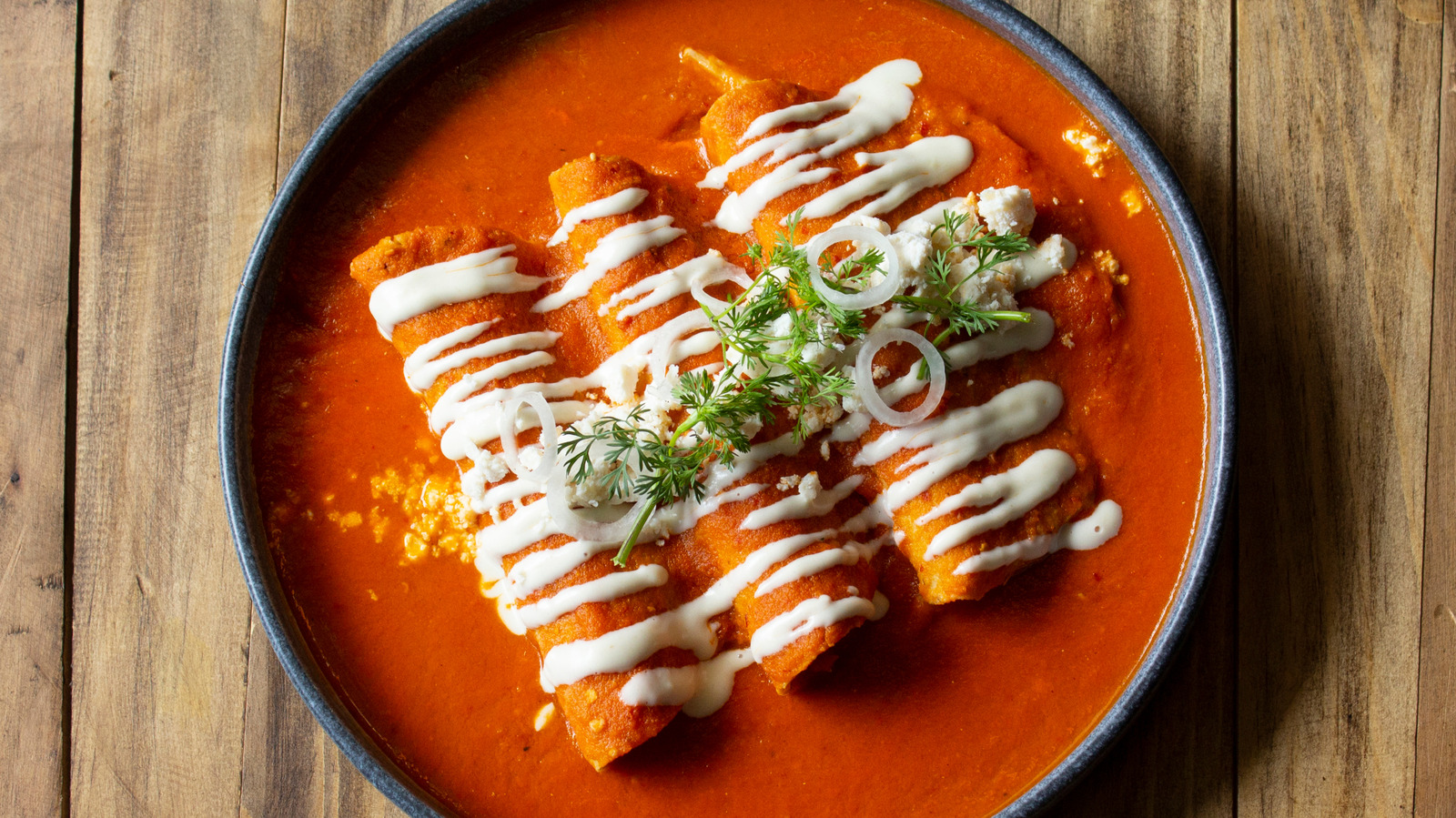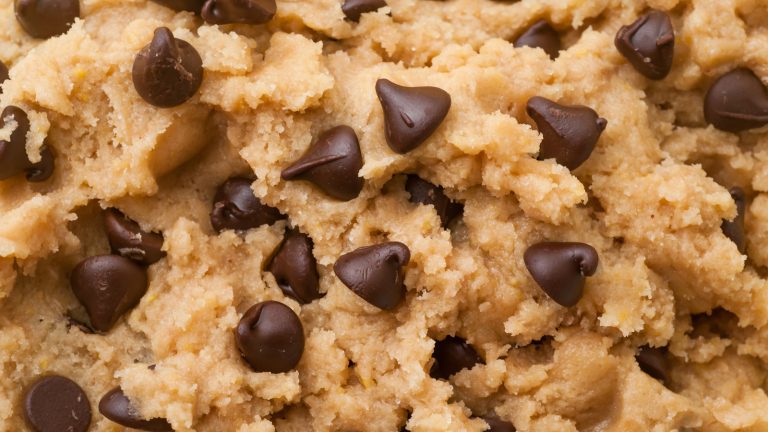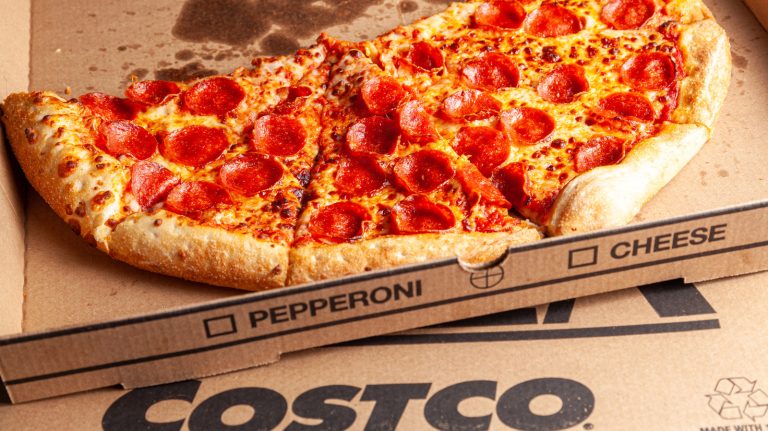Meaty, cheesy, and saucy, enchiladas can be an ultra-satisfying meal if done right. Get them wrong, and you could end up with a greasy, soggy mess. Like any dish with multiple components, enchiladas leave plenty of room for error. Use the wrong tortilla, and they might fall apart or turn rubbery. Overstuff them, and they become difficult to roll or could burst open in the oven. Then there is the matter of watery sauce and bland, boring flavors. Even experienced home cooks can make small mistakes that can throw the whole dish off.
To find out what really goes wrong when people make enchiladas at home, we talked to chefs who know the dish inside and out. They broke down the most common mistakes they see time and again like not prepping the tortillas properly, rushing the sauce, and overlooking key ingredients you need for truly great Mexican food. They also offered some insider tips for sidestepping those issues and creating a truly stellar dish. If you’ve struggled making enchiladas at home, these are some mistakes to look out for and how to avoid them.
Using the wrong type of tortillas
All the chefs we spoke to were unanimous about one thing, and that’s flour tortillas have no place in enchiladas. As Iliana de la Vega, head chef at El Naranjo, told us, “Corn tortillas are essential. It’s a completely different dish otherwise … Yellow or white is up to personal taste, but corn is non-negotiable.” Corn tortillas not only give a nice earthy flavor to the dish that can stand up nicely to bold sauces, but they also absorb less liquid than flour tortillas, so you’re less likely to get soggy enchiladas.
Several the chefs we spoke to also pointed out that you want your corn tortillas as fresh as you can get. Chef David Figueroa, president and co-founder of Melinda’s Foods recommended either making them yourself or seeking out shops that specialize in tortillas like tortillerías. He said, “Fresh tortillas are the ultimate difference-maker in any masa-based dish. The flavor, texture, and pliability are on another level. It elevates everything else around it.” If you must go store-bought, avoid frozen or refrigerated tortillas because they can get dried out and tear easily.
Not frying the tortillas first
One of the most frustrating things about making enchiladas at home is when the tortillas crack or fall apart as you roll them. Fortunately, several chefs we spoke to offered a sure-fire method for avoiding that issue. Iliana de la Vega told us, “A key prep step that many skip is lightly passing the tortilla through hot oil, not to make it crispy, but just enough to soften it. This makes them pliable for rolling or folding without cracking.”
In addition to making the tortillas easier to roll, the quick fry creates a light barrier that helps prevent the sauce from soaking in too quickly, which is one of the main reasons enchiladas turn soggy. The best way to fry your tortillas is to heat a thin layer of oil (vegetable or neutral oil works best) until it shimmers, then pass each tortilla through for just a few seconds per side. After frying, let the tortillas drain on paper towels to remove excess oil. It’s a quick process and makes a noticeable difference in texture and structure.
Going with the wrong type of cooking fat
Most people don’t think too much about the fat they use when cooking enchiladas, but chef Octavio Enciso Sandoval of Boca del Cielo and Gallo y Toro Fonda believes they should. He told us, “Traditional enchiladas are made with pork lard. Now, many people make them with oil, perhaps to save time, but they should be made with lard.” This versatile cooking fat adds richness and depth, giving your tortillas and fillings a savory flavor and a more satisfying mouthfeel.
If you’re not familiar with lard, it’s rendered pork fat. It’s typically soft like butter and creamy white. When heated, it melts into an oil. Good quality lard has a delicate flavor that’s not nearly as porky as you would think. You can often find it at Latin markets or butcher shops. You may also be able to find it in grocery stores, but the shelf-stable versions sold in blocks tend to be hydrogenated and often lack that clean, savory flavor you want. If pork isn’t an option, duck fat, beef tallow, or butter can offer similar richness, but each can change the overall profile.
Opting for sauce from a can or jar
You might consider using store-bought sauces or even salsa for your enchiladas to save time. However, many chefs would argue that’s one of the fastest ways to flatten the flavor. As Yvette Marquez, founder of Muy Bueno, told us, “A mediocre enchilada might have all the right components, but if the sauce is bland, store-bought, or made with chili powder, it’s just not going to hit the same. A great enchilada starts with a homemade sauce made from real dried chiles or roasted tomatillos and fresh ingredients.”
If it’s red sauce you’re going for, Marquez recommends using dried chilies like guajillo, ancho, or New Mexico chiles and rehydrating them, then blending them with simple ingredients like garlic and salt. For salsa verde, she’s a big fan of tomatillos or green chilies like hatch, anaheim, or chilacas. For people who can’t handle too much heat, poblanos are a milder option. Marquez also recommends blending your roasted green chiles with sour cream or crema for a creamy texture that works beautifully with the smoky flavor of the chiles.
Sticking to just one style
If your idea of enchiladas begins and ends with red sauce and melted cheese, that’s only a fraction of what’s out there. Iliana de la Vega pointed out countless regional styles across Mexico, plus Tex-Mex variations. For example, you have enchiladas verdes with tomatillo salsa verde, enchiladas suizas in a creamy salsa verde with tangy cheese, and enmoladas drizzled with a rich mole sauce. And in the Tex-Mex canon, you’ll find enchiladas smothered in chili gravy.
If you’re stuck in a rut, the easiest way to experiment is by switching up the sauce. Try swapping out your usual red sauce for a homemade tomatillo salsa or a simple mole if you’re up for a project. You can also try baking your enchiladas in a creamy sauce with a sprinkle of queso fresco for a suiza-style twist or layering in roasted vegetables or shredded chicken to change up the filling. Garnishes like raw onion, avocado slices, pickled jalapeños, or fresh herbs can shift the whole flavor profile. Once you know the basic method, enchiladas are incredibly flexible. Don’t be afraid to mix elements and make them your own.
Rushing the sauce and the filling
We’ve all been there — trying to get dinner on the table, rushing through the sauce, and tossing together a filling without much thought. But when it comes to enchiladas, those shortcuts almost always show in the final dish. As Wes Avila of MXO by Wes Avila told us, “My top piece of advice would be to focus on the quality and preparation of your ingredients. Use fresh tortillas, season your fillings well, and don’t rush the sauce. Take the time to build those flavors!”
Chefs we spoke to indicated that good enchilada sauces and fillings don’t need to be overly complicated, but they do need care. If either one is flat or underdeveloped, no amount of cheese can make up for it. To add complexity, chef Dennis Littley, founder of Ask Chef Dennis, recommended toasting your dried chiles and blooming your spices in oil to wake up the flavors. David Figueroa suggested seasoning the filling with fresh ingredients and cooking it low and slow so that it’s reduced and packed with flavor. And as Iliana de la Vega told us, tasting as you go along can help ensure every element is well seasoned and on point.
Treating the enchiladas like burritos
At a glance, enchiladas and burritos might seem interchangeable. Both involve tortillas filled with savory ingredients and served with a chile sauce. But beyond that, they’re entirely different dishes, and mixing them up can lead to disappointing results. As David Figueroa says, “People treat enchiladas like burritos with gravy, and that’s where it all goes sideways.” The biggest misstep he sees? Using burrito-style fillings in enchiladas.
Burritos are meant to be hearty hand-held meals that are packed with a variety of textures. Think crisp lettuce, firm beans, and soft rice. Enchiladas, on the other hand, are about balance and cohesion. They’re typically smaller, softer, and built to highlight the sauce as much as the filling. Figueroa recommends using ingredients that meld together well, like braised meats, tender fish, or seasoned vegetables. Moist, well-integrated fillings help everything stay together and deliver a better bite. “Also, big chunks are a no-no,” he said. “Enchiladas should be fork-tender with a texture that feels cohesive in every bite. If you need a knife, it’s already gone too far.”
Neglecting to balance the flavors
Many home cooks focus on the texture or presentation of their enchiladas, but forget how all the flavors work together. As Wes Avila said, “A mediocre enchilada often lacks depth and balance. A great one has a perfect harmony of flavors, texture, and freshness.” That harmony often comes from thoughtful pairings like mild shredded chicken with a tangy tomatillo salsa or rich beef with a vibrant red chile sauce. The key is considering how different ingredients can complement and contrast one another.
One of the easiest and most overlooked ways to balance flavor is through your choice of cheese. Yvette Marquez told us, “The right cheese can really elevate your enchiladas and play up the flavor of the sauce.” She loves pairing a bold red chile sauce with mild, melty cheeses like Colby or Asadero and salsa verde with a smooth Muenster. Suiza-style enchiladas can benefit from mild cheeses like Oaxaca or a tangy cheese like Monterey Jack. “For a final touch, enchiladas can be topped with a dusting of salty, crumbly queso fresco or queso cotija,” Marquez said.
Assuming enchiladas have to be rolled and baked in a casserole dish
Think enchiladas have to come in casserole form? Think again. Yvette Marquez told us, “That’s not how I grew up eating them. In Northern Mexico and El Paso, where I’m from, enchiladas were usually stacked and layered — flat. Sometimes we’d roll them, but more often than not, it was all about those layers.” She has fond memories of eating fresh, hot tortillas with simple layers of cheese, onions, and sometimes a fried egg. And there was always red or green chile sauce for dipping. “No baking dish, no casserole situation,” she said.
Marquez’s go-to method of stacking tortillas with layers of sauce and toppings is fast, flexible, and easy to scale. You can build them directly on the plate and eat them while they’re still hot and saucy. Another option is to dip tortillas in warm chile sauce, fold them over with a bit of filling, and serve them like tacos. For a twist, try topping each tortilla individually like a mini tostada. Just be sure to spoon the sauce over while everything is still warm so it soaks in without making things soggy.
Overstuffing the tortillas
It may be tempting to pack as much filling as you can into your tortillas to create ultra-hearty enchiladas, but that can cause problems. Dennis Littley told us, “When it comes to fillings, less is often more. I see people overload enchiladas with dry chicken breast, overcooked ground beef, or way too much cheese. The result is either a soggy mess or something that tastes flat.” In addition, overstuffing can cause the tortillas to break as you’re rolling them or while they’re in the oven, which in turn can cause uneven cooking.
The goal is to keep things well-balanced. If you’re using moist, flavorful ingredients, you don’t need to overload the tortillas. Littley recommends using shredded rotisserie chicken tossed with a bit of sauce or tender, slow-cooked pork. Both can add richness and flavor even in smaller amounts. To add interest, mix in some beans or roasted vegetables, but keep the portions in check. About half a cup of filling per tortilla is usually enough. Anything more, and you risk losing that ideal bite where the filling, tortilla, and sauce all come together.
Rolling and placing the tortillas improperly
Even if you’ve nailed your fillings and sauce, poor assembly can still ruin your enchiladas. Several missteps can cause them to dry out, fall apart, or stick to the pan or baking dish. Wes Avila told us, “For assembly, it’s important to coat the bottom of the baking dish with sauce to prevent sticking. Roll the tortillas tightly, and don’t overcrowd the dish. Also, making sure to cover them with sauce and cheese before baking will help them stay moist.”
Dennis Littley offered another tip to help prevent your enchiladas from turning out sloppy. He said, “To keep everything from falling apart, I always recommend letting the filling cool a bit before rolling. Hot fillings can steam the tortillas from the inside and make them mushy.” He also recommended going easy on the filling so that you can roll the tortillas tightly and placing them in the dish or pan seam side down to prevent them from opening in the oven mid-bake.
Being haphazard with layering
Layering enchiladas might seem straightforward, but a rushed or messy job can throw off the balance of the dish. ” I always say, treat it like lasagna,” said Yvette Marquez. She recommends starting with a spoonful of sauce on the bottom of the dish, then adding the rolled tortillas with just enough sauce to coat them, and then adding cheese or crema last. Iliana de la Vega uses a similar method but with layered tortillas instead of rolled or folded. She also starts with sauce, then a tortilla, filling, and more sauce, repeating as needed. The final layer is the cheese. “It’s similar to a lasagna and is often referred to as Pastel Azteca in Mexico,” she said.
Several of the chefs we spoke to also pointed out that balance is key. For example, Wes Avila told us, “Many home cooks either skimp on the sauce or drown the enchiladas in it. You want enough to complement the dish without overwhelming the flavors of the filling or making the tortilla soggy.” He suggested adding spice or herbs in between layers, as well as a sprinkle of cheese and a drizzle of sauce to amp up the flavor.
Overbaking the enchiladas
One of the easiest ways to ruin a good tray of enchiladas is by leaving them in the oven too long. Remember that many of the ingredients are already cooked, so they don’t need that much time in the oven. As Yvette Marquez said, “You’re not cooking them from scratch, just heating them through until the cheese melts and everything is warm. Overbaking is how you end up with mushy tortillas.” It’s all about controlling the temperature, timing, and setup.
Before assembling your enchiladas, preheat the oven to 350 degrees Fahrenheit. If you’ve prepared your enchiladas ahead of time and are baking them from the fridge, let them sit at room temperature for 15 to 20 minutes or add a few minutes to the bake time. Consider covering the dish with aluminum foil to help trap moisture and prevent over-browning or drying out. Bake the enchiladas for about 15 to 20 minutes until the cheese is melted and bubbly and the enchiladas are heated throughout. Finish them uncovered for two to three minutes if you want a lightly golden top.





